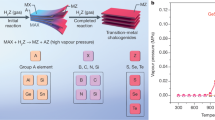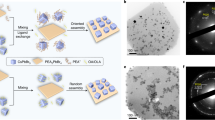Abstract
Two-dimensional (2D) materials with multiphase, multielement crystals such as transition metal chalcogenides (TMCs) (based on V, Cr, Mn, Fe, Cd, Pt and Pd) and transition metal phosphorous chalcogenides (TMPCs) offer a unique platform to explore novel physical phenomena. However, the synthesis of a single-phase/single-composition crystal of these 2D materials via chemical vapour deposition is still challenging. Here we unravel a competitive-chemical-reaction-based growth mechanism to manipulate the nucleation and growth rate. Based on the growth mechanism, 67 types of TMCs and TMPCs with a defined phase, controllable structure and tunable component can be realized. The ferromagnetism and superconductivity in FeXy can be tuned by the y value, such as superconductivity observed in FeX and ferromagnetism in FeS2 monolayers, demonstrating the high quality of as-grown 2D materials. This work paves the way for the multidisciplinary exploration of 2D TMPCs and TMCs with unique properties.
This is a preview of subscription content, access via your institution
Access options
Access Nature and 54 other Nature Portfolio journals
Get Nature+, our best-value online-access subscription
$29.99 / 30 days
cancel any time
Subscribe to this journal
Receive 12 print issues and online access
$259.00 per year
only $21.58 per issue
Buy this article
- Purchase on Springer Link
- Instant access to full article PDF
Prices may be subject to local taxes which are calculated during checkout





Similar content being viewed by others
Data availability
The main data supporting the findings of this study are available within the article and Supplementary Information. Additional data are available from the corresponding authors upon reasonable request.
References
Schaibley, J. R. et al. Valleytronics in 2D materials. Nat. Rev. Mater. 1, 16055 (2016).
Radisavljevic, B., Radenovic, A., Brivio, J., Giacometti, V. & Kis, A. Single-layer MoS2 transistors. Nat. Nanotechnol. 6, 147–150 (2011).
Kang, K. et al. High-mobility three-atom-thick semiconducting films with wafer-scale homogeneity. Nature 520, 656–660 (2015).
Zhou, J. et al. A library of atomically thin metal chalcogenides. Nature 556, 355–359 (2018).
Lee, Y. H. et al. Synthesis of large-area MoS2 atomic layers with chemical vapor deposition. Adv. Mater. 24, 2320–2325 (2012).
Kang, L. et al. Phase-controllable growth of ultrathin 2D magnetic FeTe crystals. Nat. Commun. 11, 3729 (2020).
Zhang, Y. et al. Ultrathin magnetic 2D single-crystal CrSe. Adv. Mater. 31, e1900056 (2019).
Chu, J. et al. Sub-millimeter-scale growth of one-unit-cell-thick ferrimagnetic Cr2S3 nanosheets. Nano Lett. 19, 2154–2161 (2019).
Meng, L. et al. Anomalous thickness dependence of Curie temperature in air-stable two-dimensional ferromagnetic 1T-CrTe2 grown by chemical vapor deposition. Nat. Commun. 12, 809 (2021).
Ma, H. et al. Phase-tunable synthesis of ultrathin layered tetragonal CoSe and nonlayered hexagonal CoSe nanoplates. Adv. Mater. 31, e1900901 (2019).
Chen, S., Liu, H., Chen, F., Zhou, K. & Xue, Y. Synthesis, transfer, and properties of layered FeTe2 nanocrystals. ACS Nano 14, 11473–11481 (2020).
Shivayogimath, A. et al. A universal approach for the synthesis of two-dimensional binary compounds. Nat. Commun. 10, 2957 (2019).
Zhao, B. et al. Synthetic control of two-dimensional NiTe2 single crystals with highly uniform thickness distributions. J. Am. Chem. Soc. 140, 14217–14223 (2018).
Hsu, F. C. et al. Superconductivity in the PbO-type structure α-FeSe. Proc. Natl Acad. Sci. USA 105, 14262–14264 (2008).
Gudelli, V. K., Kanchana, V., Vaitheeswaran, G., Valsakumar, M. C. & Mahanti, S. D. Thermoelectric properties of marcasite and pyrite FeX2 (X = Se, Te): a first principle study. RSC Adv. 4, 9424–9431 (2014).
Deng, Y. et al. Gate-tunable room-temperature ferromagnetism in two-dimensional Fe3GeTe2. Nature 563, 94–99 (2018).
Wang, D. et al. Evidence for Majorana bound states in an iron-based superconductor. Science 362, 333–335 (2018).
Kong, L. et al. Half-integer level shift of vortex bound states in an iron-based superconductor. Nat. Phys. 15, 1181–1187 (2019).
Bansal, D. et al. Magnetically driven phonon instability enables the metal–insulator transition in h-FeS. Nat. Phys. 16, 669–675 (2020).
Kang, S. et al. Coherent many-body exciton in van der Waals antiferromagnet NiPS3. Nature 583, 785–789 (2020).
Li, H., Li, Y., Aljarb, A., Shi, Y. & Li, L. J. Epitaxial growth of two-dimensional layered transition-metal dichalcogenides: growth mechanism, controllability, and scalability. Chem. Rev. 118, 6134–6150 (2018).
Zhang, P. et al. Multiple topological states in iron-based superconductors. Nat. Phys. 15, 41–47 (2018).
Wang, Z. et al. Evidence for dispersing 1D Majorana channels in an iron-based superconductor. Science 367, 104–108 (2020).
Gusmao, R., Sofer, Z. & Pumera, M. Metal phosphorous trichalcogenides (MPCh3): from synthesis to contemporary energy challenges. Angew. Chem. Int. Ed. 58, 9326–9337 (2019).
Cain, J. D., Shi, F., Wu, J. & Dravid, V. P. Growth mechanism of transition metal dichalcogenide monolayers: the role of self-seeding fullerene nuclei. ACS Nano 10, 5440–5445 (2016).
Zhu, D. et al. Capture the growth kinetics of CVD growth of two-dimensional MoS2. npj 2D Mater. Appl. 1, 8 (2017).
Li, S. et al. Vapour–liquid–solid growth of monolayer MoS2 nanoribbons. Nat. Mater. 17, 535–542 (2018).
Long, G. et al. Isolation and characterization of few-layer manganese thiophosphite. ACS Nano 11, 11330–11336 (2017).
Kamihara, Y., Watanabe, T., Hirano, M. & Hosono, H. Iron-based layered superconductor La[O(1–x)Fx]FeAs (x = 0.05–0.12) with Tc = 26 K. J. Am. Chem. Soc. 130, 3296–3297 (2008).
Mizuguchi, Y., Tomioka, F., Tsuda, S., Yamaguchi, T. & Takano, Y. Superconductivity at 27 K in tetragonal FeSe under high pressure. Appl. Phys. Lett. 93, 152505 (2008).
Si, W. et al. Superconductivity in epitaxial thin films of Fe1.08Te:Ox. Phys. Rev. B 81, 092506 (2010).
Margadonna, S. et al. Crystal structure of the new FeSe(1–x) superconductor. Chem. Commun. 2008, 5607–5609 (2008).
McQueen, T. M. et al. Tetragonal-to-orthorhombic structural phase transition at 90 K in the superconductor Fe1.01Se. Phys. Rev. Lett. 103, 057002 (2009).
Li, S. et al. First-order magnetic and structural phase transitions inFe1+ySexTe1−x. Phys. Rev. B 79, 054503 (2009).
Kuhn, S. J. et al. Structure and property correlations in FeS. Phys. C Supercond. Appl. 534, 29–36 (2017).
Terashima, T. et al. Upper critical field and quantum oscillations in tetragonal superconducting FeS. Phys. Rev. B 94, 100503 (2016).
Lai, X. et al. Observation of superconductivity in tetragonal FeS. J. Am. Chem. Soc. 137, 10148–10151 (2015).
Puthirath, A. B. et al. Apparent ferromagnetism in exfoliated ultrathin pyrite sheets. J. Phys. Chem. C 125, 18927–18935 (2021).
Acknowledgements
This work was supported by the National Key R&D Program of China (grant no. 2020YFA0308800) and the NSF of China (grant nos. 62174013, 11504046 12061131002 and 11734003). This work was also supported by the National Research Foundation—Competitive Research Program (NRF-CRP22-2019-0007, NRF-CRP21-2018-0007 and NRF2020-NRF-ISF004-3520). This work was also supported by the Singapore Ministry of Education Tier 3 Programme ‘Geometrical Quantum Materials’ (MOE2018-T3-1-002), AcRF Tier 2 (MOE2019-T2-2-105) and AcRF Tier 1 RG161/19 and RG7/21. W.B.G. acknowledges the support of NRF CRP by NRF-CRP22-2019-0004. G.L. and L. Lu acknowledge fundings from the National Natural Science Foundation of China under grant numbers 92065203 and 11874406, and the Strategic Priority Research Program of the Chinese Academy of Sciences (grant no. XDB33010300). Y.Y. was supported by the National Key R&D Program of China (grant no. 2016YFA0300600). C.Z. acknowledges the Fundamental Research Funds for the central Universities. F.D. and J.D. acknowledge funding from the Institute for Basic Science, Republic of Korea (IBS‐R019‐D1) and the use of the IBS‐CMCM high‐performance computing system Cimulator. This work was also supported by the Innovation Program of Shanghai Municipal Education Commission (no. 2019-01-07-00-09-E00020) and Shanghai Municipal Science and Technology Commission (18JC1412800). Y.-C.L. and K.S. acknowledge JSPS-KAKENHI (JP16H06333 and 18K14119), JSPS A3 Foresight Program and Kazato Research Encouragement Prize. H. Yang acknowledges funding from the Chinese Academy of Sciences (grant nos. XDB33030100). Y.Y. acknowledges the Strategic Priority Research Program of the Chinese Academy of Sciences (grant no. XDB30000000).
Author information
Authors and Affiliations
Contributions
J.Z. and Y. Zhou observed the growth mechanism and grew all the materials. J.Z. carried out the Raman and AFM characterizations. C.Z. performed the STEM characterizations and data analysis of the Fe-based samples other than Fe3GeTe2. Y.-C.L. and K.S. analysed Fe3GeTe2 and all the metal phosphorous chalcogenides. J.Z., Y. Zhou, C. Z. and Z.L. analysed the growth mechanism. Y. Zhou, J.Z. and B.T. performed the X-ray photoelectron spectroscopy test. Y. Zhou, H. Yu and Y.G. performed the TGA-DSC measurements. G.L., R.Z. and Y.Y. performed the electronic structure calculations. J.D. and F.D. performed the DFT calculations on the formation mechanism of FeSx with different compositions and phases. P.L. and G.L. measured the superconductivity in FeX and ferromagnetism in FeS2. J.S. measured the SHG properties in MPX3. Z.W. and W.H. used the infrared photodetector for FeTe2. J.Z., Y. Zhou, C.Z., G.-B.L., Y.Y. and Z.L. wrote the paper. All the authors discussed and commented on the manuscript.
Corresponding authors
Ethics declarations
Competing interests
The authors declare no competing interests.
Peer review
Peer review information
Nature Materials thanks Sufei Shi and the other, anonymous, reviewer(s) for their contribution to the peer review of this work.
Additional information
Publisher’s note Springer Nature remains neutral with regard to jurisdictional claims in published maps and institutional affiliations.
Supplementary information
Supplementary Information
Supplementary Figs. 1–84, Tables 1–6 and Sections 1–5.
Rights and permissions
About this article
Cite this article
Zhou, J., Zhu, C., Zhou, Y. et al. Composition and phase engineering of metal chalcogenides and phosphorous chalcogenides. Nat. Mater. 22, 450–458 (2023). https://doi.org/10.1038/s41563-022-01291-5
Received:
Accepted:
Published:
Issue Date:
DOI: https://doi.org/10.1038/s41563-022-01291-5
This article is cited by
-
Expanding the landscape of anti-MoS2 monolayers: computational exploration of stability and multifaceted properties across the periodic table
Science China Materials (2024)
-
Electrochemical molecular intercalation and exfoliation of solution-processable two-dimensional crystals
Nature Protocols (2023)
-
Phase- and composition-controlled synthesis
Nature Materials (2023)
-
Colloid driven low supersaturation crystallization for atomically thin Bismuth halide perovskite
Nature Communications (2023)
-
Vapour-phase deposition of two-dimensional layered chalcogenides
Nature Reviews Materials (2023)



